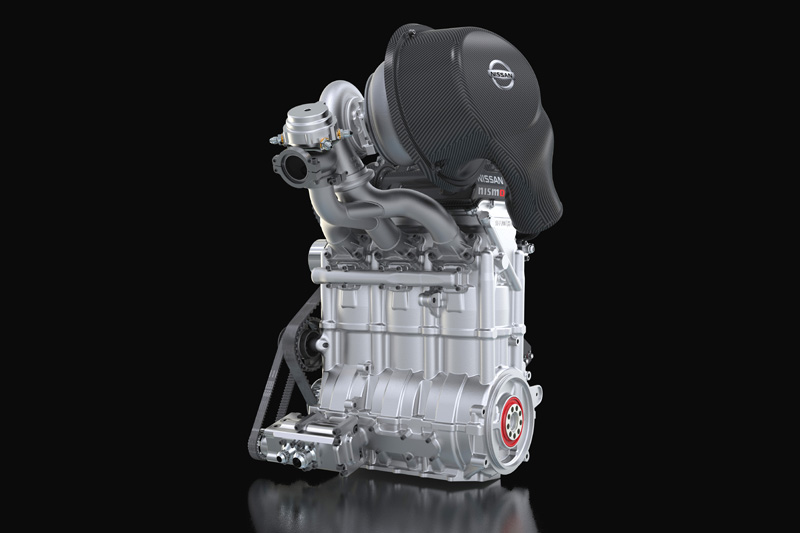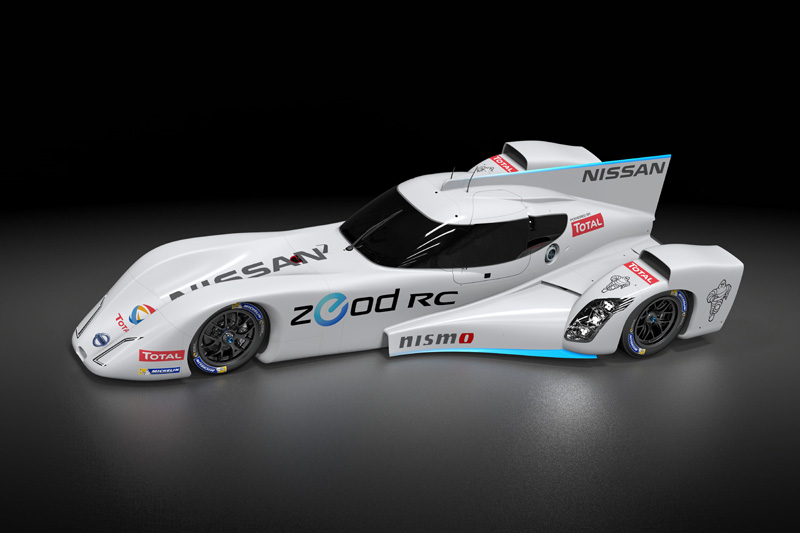Nissan will introduce two new concepts in the Nissan ZEOD RC at Le Mans this year with the electric power plant and the accompanying internal combustion engine.
The Nissan ZEOD RC will become the first entry at Le Mans to complete a lap of the Circuit de la Sarthe under nothing but electric power in June. A single lap of each stint (a fuel “stint” lasts approximately one hour) will be electric powered, then the new Nissan DIG-T R 1.5 liter three-cylinder turbo engine will take over.
The small engine weighs 40 kilograms but produces 400 horsepower. The base engine is 500 mm tall x 400 mm long x 200 mm wide. Revving to 7,500 rpm, the Nissan DIG-T R produces 380 Nm of torque. At a ratio of 10 horsepower per kilogram – the new engine actually has a better power-to-weight ratio than the new engines to be used in the FIA Formula 1 World Championship this year.
With the entire concept of the Nissan ZEOD RC focusing on downsizing and efficiency, Nissan turned to new lubricants partner Total to help develop the engine. The French lubricants manufacturer has worked closely with Nissan engineers to develop fuel and lubricants to maximize the potential of the engine.
The Nissan ZEOD RC will occupy “Garage 56” at this year’s Le Mans 24 Hours, an additional entry reserved by the Automobile Club de l‘Ouest for new and ground-breaking technologies never previously seen at the classic French endurance event. Lessons learned from the development of the racecar will also be used in the development of Nissan’s planned entry into the LM P1 class of the FIA World Endurance Championship in 2015.
“Our engine team has done a truly remarkable job with the internal combustion engine,” said Darren Cox, Nissan’s Global Motorsport Director.
“We knew the electric component of the Nissan ZEOD RC was certainly going to turn heads at Le Mans but our combined zero emission on demand electric/petrol power plant is quite a stunning piece of engineering. Nissan will become the first major manufacturer to use a three-cylinder engine in major international motorsport. We’re aiming to maintain our position as industry leaders in focusing on downsizing. Lessons learned from the development of the engine will be seen in Nissan road cars of the future.”
“Our aim is to set new standards in efficiency in regards to every aspect of the car – power train, aerodynamics and handling. For the power train we have worked closely with the team at Total to not only reduce friction inside the engine, but within all components of the power train. Friction is the enemy of horsepower and tackling that has been one of the efficiency targets we have concentrated on heavily.”
After extensive dyno testing, the Nissan ZEOD RC hit the track for the first time last week with both the electric and internal combustion engines in place. Both the petrol and electric power plants run through the same five-speed gearbox that transfers power to the ground via Michelin tires.
“Being chosen by a car manufacturer as a technological partner to achieve a demonstration of innovation is always a source of pride, especially on this legendary race – 24 Hours of Le Mans. It drives our researchers to find solutions and get the most out of the technical specifications as well as the fuel economy properties that our TOTAL QUARTZ lubricants range provides to all passengers cars”, said Philippe Girard, Scientific Delegate for Total.
The Nissan ZEOD RC will undergo an extensive test program over the next four months prior to it making its race debut at this year’s Le Mans 24 Hours on June 14-15.
Source: Nissan Motorsport
Romain’s opinion:
The engine revealed is really impressing in terms of performances. This could be a real candidate for equipping serial production hybrid vehicles like BMW i8 or Lexus LS 600h as a serial or parallel hybrid engine. Do you think processes employed for assembling the DIG-T R engine are compatible with serial production? What is the durability of this engine?




















